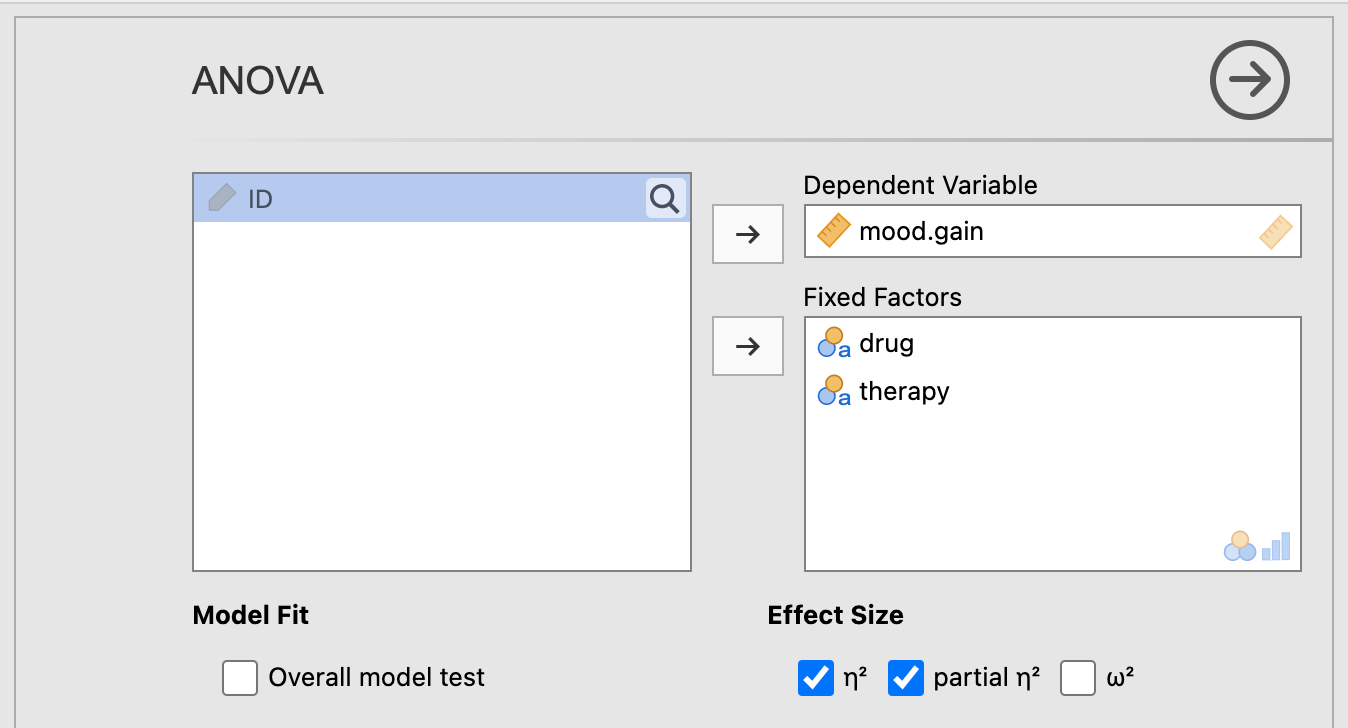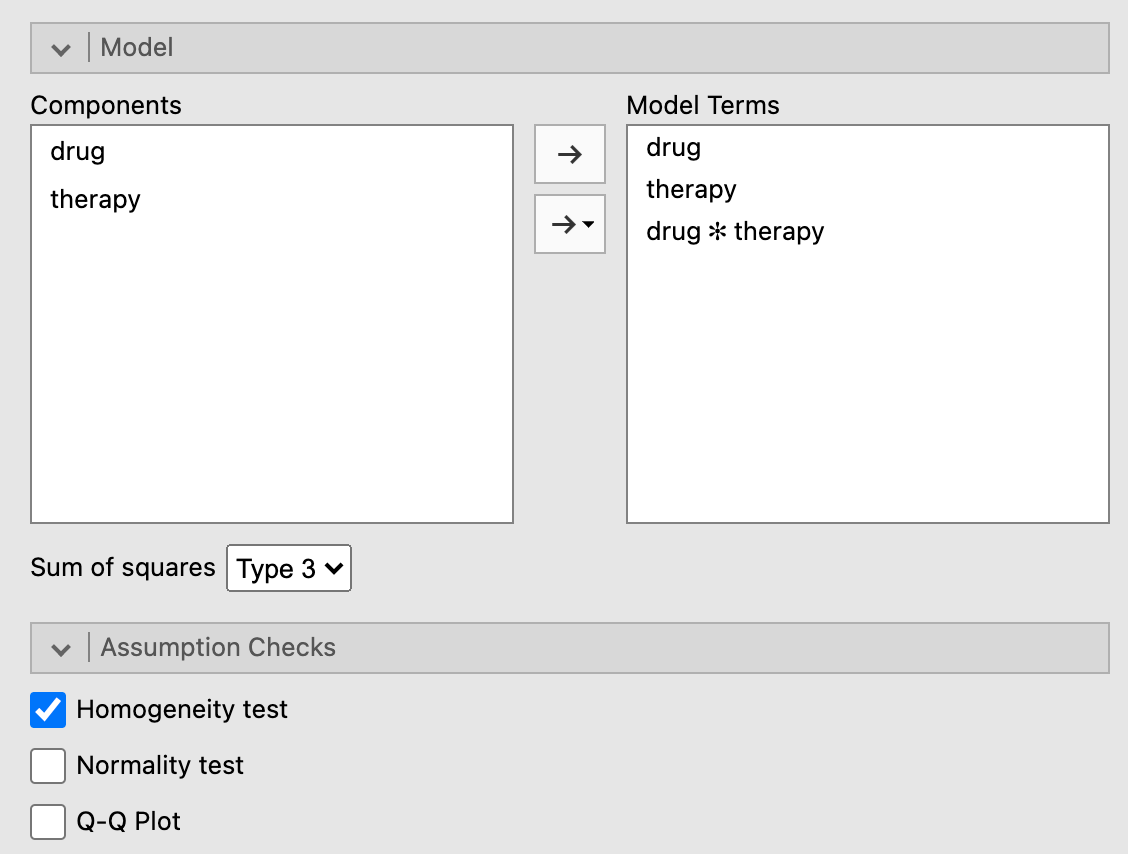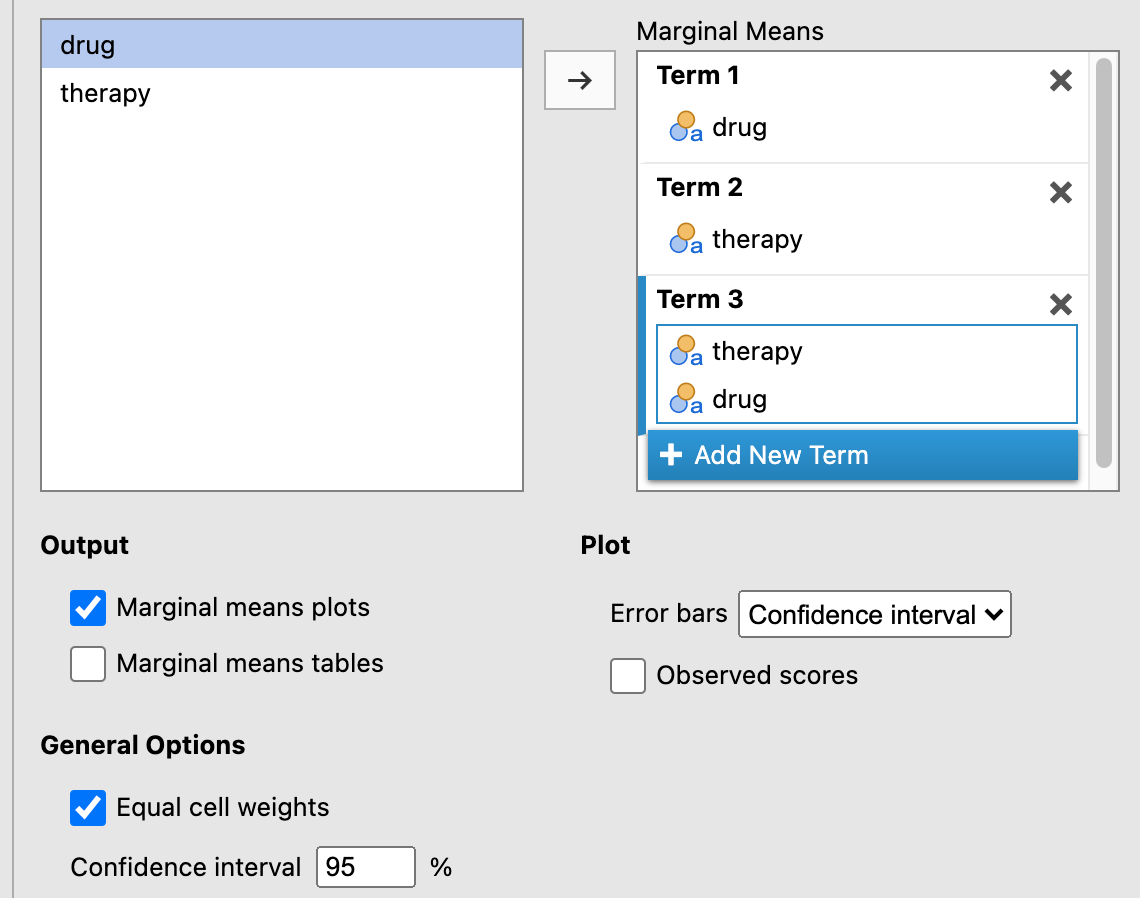Chapter 9 Factorial ANOVA
Sometimes you have more than one predictor variable. This chapter covers the case when you have two or more nominal predictor variables that might operate independently or together to account for variance in the outcome variable. This is called a Factorial ANOVA.
There are a few new concepts that come into play when discussing factorial ANOVAs. One is in the name itself. That is, the notion of a factor (from factorial) is quite important. It turns out that the experimental traditional of statistical analysis that developed alongside the correlational approach in the early 20th century adopted the label factor to describe nominal predictors.
So it’s really that simple, a factor is simply a new name for a nominal predictor. Researchers from the correlational approach to statistics don’t use this term, but those from the experimental approach do. So the bad news is that there is a new redundant term you need to learn; the good news is that the concept is not new.
The second concept that is new is actually a new concept altogether: the interaction. Up to this point, we have only discussed one predictor at a time. It may have been a nominal predictor with only four levels (e.g., the factor Class Level, with Freshman, Sophomore, Junior, and Senior as levels of that factor).
However, when you have more than one predictor, they can interact with each other.84. This means that if you have two factors, like Gender and Class Level, you can analyze three types of effects on the outcome variable:
- The main effect of
Gender
- The main effect of
Class Level
- The interaction between
GenderandClass Level
A main effect can be interpreted in the same way that a single predictor was interpreted in a oneway ANOVA. That’s all the label refers to: the effect of one particular predictor, by itself, on the outcome variable in your analysis. So using our Gender \(\times\) Class Level example from directly above, a main effect for Gender would imply a significant difference across the various levels of Gender (e.g., male, female, not listed).
An interaction, however, is a new concept. It is the effect one predictor on the outcome, but moderated by another predictor. If you are using only factors, as we are in this chapter, then this amounts to the following: A significant interaction is when the effect of one factor depends on the levels of another factor. For example, it might be the case that genders do indeed differ on their Overall Student Satisfaction, but only for upperclassmen (juniors and seniors); but for underclassmen, there are no differences across genders for Overall Student Satisfaction.
If you have two factors, then the possible number of significant results is 3. But it is also possible to include three factors (e.g., Gender \(\times\) Class Level \(\times\) College). In this case, there are three possible main effects (1-3 below), and four possible interactions (4-7 below):
- main effect for
Gender
- main effect for
Class Level
- main effect for
College
- two-way interaction between
GenderandClass Level
- two-way interaction between
GenderandCollege
- two-way interaction between
Class LevelandCollege
- three-way interaction among
Gender,Class Level, andCollege
And if you have four factors, the number of possible interactions increases to ten!!
So you can see how things can get complicated very quickly. For this reason, most researchers try to keep their analyses as simple as possible for interpretation purposes. This is especially true since a four-way interaction (i.e., A \(\times\) B \(\times\) C \(\times\) D, possible only with a factorial ANOVA with four factors) is very difficult to visualize, and virtually impossible for humans to conceptualize. Interestingly, there is nothing stopping the software from calculating. You can obtain a four-way interaction and even higher order interactions, but you will have great difficulty interpreting them. To the extent that this is true, such statistical models risk losing their scientific utility since they do not contribute to human understanding.85
Carrying out a factorial ANOVA is covered in your main textbook (Navarro & Foxcroft, 2019, Chapter 14). We will not cover the mathematics of this in the lab manual however. Although the calculation for each main effect and interaction is ultimately converted into the same F-ratio found in 8, the partitioning out of main effects and interactions can get complicated. How to do this is covered in the main textbook (Navarro & Foxcroft, 2019, sec. 14.1.3 to 14.1.4).
So at this point, it is useful to demonstrate how to carry out a factorial ANOVA in jamovi, along with how to interpret the output.
9.1 Basic: joyzepam data
This is the same artificial data set from used above in section 8.1.1. Again, the hypothetical scenario is researchers looking at overall mood gain among three groups of participants (N=18) battling depression under different drug regimens: joyzepam, anxifree, and a placebo. There are six patients in each group. Furthermore, the six participants under each of these regimens is either undergoing Cognitive Behavioral Therapy (CBT) or no therapy at all (no.therapy), ultimately rendering three participants in each drug \(\times\) therapy group (a balanced data set). In contrast to the previous chapter in this lab manual (Chapter 8), we will be analyzing therapy in addition to drug to create a (two-factor) factorial ANOVA instead of a (single-factor) Oneway ANOVA.
9.1.1 Obtaining the data
To repeat from section 8.1.1.1, this data set can be found in jamovi (if you have added the lsj-datasets module) by clicking (\(\equiv\)) > File > Data Library > learning statistics with jamovi > Clinical Trial.omv.
9.1.2 Implementing the procedure
As described in section 8.1.1.2, click Analyses tab and select ANOVA > ANOVA.
Slide mood.gain into the Dependent Variables box, and both drug and therapy into the Fixed Factors box.
Under Effect Size, click both \(\eta^2\) and partial \(\eta^2\).
See Figure 9.1 directly below for a depiction of these options.

Figure 9.1: Main parameter settings for performing a factorial ANOVA using the ANOVA procedure using the Clinical Trial data from Navarro & Foxcroft (2019).
Next, click the arrow pointing to Model and make sure that both drug, therapy, and drug*therapy is placed under Model Terms (and as in the Oneway ANOVA, leave Sum of squares as Type 3.
You can test the assumption of homogeneity of variance using Levene’s Test for Homogeneity of Variance. Jcheck the box Homogeneity tests under Assumption Checks. See Figure 9.2 below for a depiction of these options.

Figure 9.2: Model settings and assumption checks for a factorial ANOVA under the ANOVA procedure using the Clinical Trial data from Navarro & Foxcroft (2019).
In a factorial ANOVA, a researcher should not really set up any post-hoc tests until they know which main effects and/or interactions are significant. The problem is that each of the main effects and interactions are separate tests, and one should only perform posthoc tests at the particular level (e.g., a particular main effect or interaction) where an F-test was significant. One cannot know this before running the omnibus test. Hence, the post- (“after”) in the term post-hoc.
In fact, this is a broader principle: Researchers should not set up post-hoc tests at all before an omnibus test. We did this for the sake of convenience in Section 8.1.1.2 above. However, you should avoid this in real situations.
That said, you can set up a priori tests (aka planned comparisons) at the same time as an omnibus test. This changes a few things, most notably the familywise error rate. But in order to “get away with” planned comparisons, a researcher must have compelling reasons that would satisfy a reviewer from whatever journal they a submitting the paper to.
For now, we will leave both types of comparisons aside.
Finally, under Estimated Marginal Means, click + Add New Term three times, and make sure that the following are true:
drugmakes it over to the box on the right underTerm 1
therapymakes it over to the box on the right underTerm 2therapyanddrugmakes it over to the box on the right underTerm 3(dragtherapyover beforedrug; it just looks better iftherapyis on the x-axis)The
Marginal means plotsbox is checked underOutput(leave theMarginal means tablesbox unchecked to simplify the output)
Equal cell weightsis checked (the default)
Error bars(underPlot) is set toConfidence interval
These options are shown in Figure 9.3 below.

Figure 9.3: Graphic settings for a factorial ANOVA under the ANOVA procedure using the Clinical Trial data from Navarro & Foxcroft (2019).
NOTE: You might be wondering whether the same logic that prevents you from planning post-hoc comparisons also applies to graphics. You would be partly correct. That is, you shouldn not try to convince your reader of main effects and/or interactions visually, when you did not establish them statistically. However, visualizations make it easier for readers to conceptualize the data summary. So as long as the author is honest about the statistical findings, visualizations that display non-significant effects can be legitimate and can actually aid the reader in understanding why such effects were not found.
The results should appear as follows (the reader may need to scroll to the right to see the full output due to the output being rounded to more decimal places):86
ANOVA
ANOVA - mood.gain
───────────────────────────────────────────────────────────────────────────────────────────────────────────
Sum of Squares df Mean Square F p η² η²p
───────────────────────────────────────────────────────────────────────────────────────────────────────────
drug 3.4533333 2 1.72666667 31.714286 0.0000162 0.7127623 0.8409091
therapy 0.4672222 1 0.46722222 8.581633 0.0126170 0.0964339 0.4169559
drug:therapy 0.2711111 2 0.13555556 2.489796 0.1246017 0.0559569 0.2932692
Residuals 0.6533333 12 0.05444444
───────────────────────────────────────────────────────────────────────────────────────────────────────────
ASSUMPTION CHECKS
Homogeneity of Variances Test (Levene's)
────────────────────────────────────────
F df1 df2 p
────────────────────────────────────────
0.2055046 5 12 0.9538432
──────────────────────────────────────── 9.1.3 Interpreting the output
As we saw for the results with the same data in Section 8.1.1.3, there was a main effect for drug. We did not call it a main effect in that case because there were no other predictors in the model. But now that we have added therapy as another predictor, as well as included a possible interaction between drug and therapy, we should discuss the effect of drug as a main effect. The main effect for drug should be interpreted as the independent effect of drug when therapy and the interaction between drug and therapy are also included in the model, but “left aside” or “neutralized.”
The other main effect for therapy was also significant [F(1,12) = 8.58, p = .013, \(\eta^2\) = .713]. It should be interpreted in the same way: specifically, the effect of therapy when both drug and the interaction between therapy and drug are both in the model, but “neutralized.”
Finally, the interaction87 between therapy and drug was not significant [F(2,12) = 2.49, p = .125].
At this point, we could run post-hoc tests to see where the significant differences are. However, post-hoc tests turn out to be unnecessary in this case. First, we already ran a Oneway ANOVA on drug in Section 8.1.1.2. From that analysis, we already know how to interpret the main effect for drug (see section 8.1.1.3 for that interpretation).
There was another significant main effect in this case: therapy. But this predictor only has two levels: CBT and no.therapy. And if you only have two levels for a significant predictor in an ANOVA, there is no need to conduct a post-hoc test for that predictor. It’s equivalent to a t-test. Specifically, the level associated with the larger mean is the level that is significantly greater than the other level, whereas the other level is significantly less. In our case, it is clear that CBT is having a significantly greater effect on mood.gain than no.therapy. No other interpretation is possible.
Finally, there is the interaction. But the interaction as not significant. This suggests that both drug and therapy are having independent effects on mood.gain. That is, both contribute to changes in mood gain, but they don’t have anything to do with one another.
The two main effects (for drug and therapy are easy enough to see in the first two erro-bar charts above. The third chart is for the non-significant interaction. As noted above, it’s okay to present a non-significant interaction in a figure as long as the researcher is honest and explains how the chart demonstrates the non-significance, rather than potential significance (or something misleading like that).
In this case, although the lines for the different drugs across treatment levels are non-parallel, the sample size (N = 18 overall, but only n = 3 in each group) was probably too small to reach significance. If so, this is an issue of power, which is the probability of rejecting the null hypothesis when it is underlyingly false; or a true positive.
So there might very well be a interaction here, where joyzepam and the placebo work equally well or poorly, respectively, regardless of the type of therapy, but anxifree works better with CBT than with no therapy at all. But this can only be speculative because of the lack of power.
This highlights the importance of properly powering your statistical analyses. That is, this hypothetical data set illustrates how there are insufficient data points (i.e., participant responses) for the complexity of the model (two predictors and the interaction between them).
9.1.4 Reporting the output
Again, APA format requires a particular pattern for statistical output:
- a letter (in italics) representing the test statistic used
- parentheses that enclose the degrees of freedom
- an equals sign
- the obtained value of the test statistic
- a comma
- the letter p in italics
- one of three symbols: =, <, or >
- a p-value
This time, however, there are three such tests to report: the two main effects and the interaction. To get the degrees of freedom - between (the first number in parentheses), look under the column df for the effect in question. To get the degrees of freedom - within (the second number in the parentheses), go to the bottom row, Residuals,88 under df (it’s the same for all the main effects and interactions). Thus, combining this new knowledge with what you learned in section 8.1.1.4, the statistical reports come out as follows:
- Main effect for
drug: \(F(2,12)=31.71,p<.001,\eta_p^2=.841\)
- Main effect for
therapy: \(F(1,12)=8.58,p=.013,\eta_p^2=.417\)
- Interaction between
drugandtherapy: \(F(2,12)=2.49,p=0.12\eta_p^2=.293\)
Now we can write a partial Results section for this analysis. It builds upon the one written in Section 8.1.1.4.
The analysis revealed a significant main effect for drug. The mood improvement over the course of three months differed significantly across the three groups of patients taking either joyzepam, anxifree, or a placebo, \(F(2,12)=31.71,p<.001,\eta_p^2=0.841\). There was also a significant main effect for therapy, \(F(1,12)=8.582,p=.013,\eta_p^2=0.417\). However, there was no interaction between the two, \(F(2,12)=2.49,p=0.12\eta_p^2=.293\).
Post-hoc comparisons for the main effect of drug with Holm corrections revealed that there was a significant difference between joyzepam (M = 1.48, SD = 0.214) and both anxifree (M = 0.717, SD = 0.392),89 \(t(15)=-4.36,p<.001\), and the placebo (M = 0.45, SD = 0.281), \(t(15)=5.88,p<.001\). However, there was no significant difference between anxifree and the placebo, \(t(15)=1.52,p=.15\). These differences are also clear in Figure 1, where it is clear that the 95% confidence interval for joyzepam does not overlap with those of either of the other two conditions, whereas the confidence intervals for the latter two conditions overlap substantially. joyzepam is clearly resulting in a significantly greater mood gain than the other two conditions. Additionally, the effect size (\(\eta_p^2=0.841\)) is quite large, suggesting that this difference between joyzepam and the other two conditions is quite substantial in magnitude.
For the main effect of therapy, it is clear that cognitive behavioral therapy has a larger mean (M = 1.04, SD = 0.45) resulted in greater mood gain than no therapy at all (M = 0.72, SD = 0.59).\(^\*\) Finally, there was no significant interaction between drug and therapy, \(F(2,12)=2.49,p=0.125,\eta_p^2=0.293\). In other words, both drug and therapy exerted an influence on mood gain, but they did not depend on each other, though the study may have been underpowered (n = 3 in each condition) as there seemed to be a trend for anxifree to work better with cognitive behavioral therapy then without any therapy at all. Future studies may reveal more about any such potential interaction.
References
Interactions are not restricted to factorial ANOVAS; they can also feature in multiple regression, where not only can nominal predictors (“factors”) interact with each other, but also continuous predictors can interact both with each other and with other nominal predictors. Interaction is called moderation in this tradition. Regardless, this chapter restricts itself to interactions among categorical predictors.↩︎
They may not lose their practical utility, however, if the sole purpose of such models is merely to make accurate predictions, as in the business world. That is, science implies human understanding of models, whereas the business world (among others) does not, necessarily.↩︎
Recall that the output below (and further down) was generated from the jmv package in R, and will therefore be rounded to more decimal places than the native output in jamovi.↩︎
You might notice a minor notational difference here. jamovi uses an asterisk (*) to represent the interaction, whereas the output directly above uses a colon (:). The asterisk is more common in publication. There is no difference. The colon is an artifact of us using the jmv package from within R, and R sometimes uses colons to represent specific interactions.↩︎
Again, the term residuals is synonymous with error, deviations, deviance, etc., and even “noise.” It refers to the variation in the data that the model could not account for (or “leftover” variation).↩︎
Note that the mean and standard deviation were obtained through jamovi’s Descriptives procedure↩︎